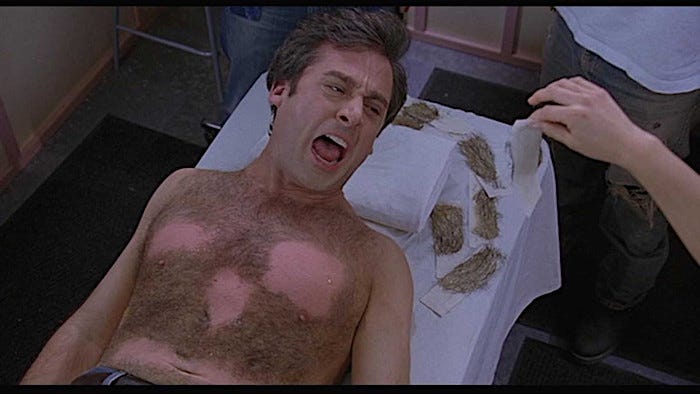Reader Question: How to indicate a ‘jump cut’ in a screenplay?
A jump cut is a transition to suggest a time ellipsis, a jump in time, hence the term.
A question from pliny the elder:
Simple formatting question: I have an overall scene where four women family members are individually and privately having their fortunes read by a fortune teller using Tarot cards.
Basically it’s broken down into 4 sequential sub-scenes, that are supposed to look the same, except that one of the women is replaced by the next.
Do I use a simple cut to: transition and a slug line, or should I use a match cut to: to indicate that these 4 sub-scenes happen in the same room?
First of,f a definition: A jump cut is a transition to suggest a time ellipsis, a jump in time, hence the term.
Despite what some screenplay format formalists may assert, there is no etched-in-stone approach. For example, there are several jump cuts or quick cuts in the script for 40 Year-Old Virgin and each one is different:
P. 19: Andy in his apartment channel surfing TV, a series of salacious commercials indicated in a list with a hyphen:
-A soap opera with people kissing.
-A commercial for Viagra.
-Teenagers making out on MTV.
P. 32: Andy gets a hot wax treatment indicated with the secondary slugline QUICK CUTS and an asterisk for each shot:
*She strips off several more hunks of hair from his back and chest.
*We see tears of pain coming down Andy’s face. This could not hurt more.

P. 44–46: Andy speed dating. Again the use of QUICK CUTS, then “Buzzer” to indicate the jump cut:
GIRL
Do you like oral sex? ANDY
By oral do you mean...phone sex. Buzzer. ANDY
I guess I love Jesus. I don't not
love him. Buzzer. ANDY
I think I am kind. I am not mean.
Oh, do you want me to be mean?
My guess is you would find a different approach to formatting jump cuts in every script you read.
Here is one way to handle it:
Verika the Tarot Card Reader flips cards, then casts a knowing
eye toward her client BARB. VERIKA
A tall dark stranger? You are not
going to meet him. CUT TO: Verika studies the cards for ANITA. VERIKA
Is your homeowners insurance paid up? CUT TO: Verika works her magic with SHELLY. VERIKA
I see a social disease in your future. CUT TO: Verika now getting flustered by her cards, sighs at REBECCA. VERIKA
What is wrong with you women? You
are like walking death!
(extends hand)
That will be twenty dollars.
That approach is clear, the only thing I don’t like about it is the use of the transition CUT TO which feels rather ‘scripty’ when the trend in the last decade or so has been away from that type of screenplay jargon. So you could swap out LATER for CUT TO. Better yet, use a hyphen or even a double dash like this ( — — ) before each line of scene description to indicate the jump in time:
— — Verika studies the cards for ANITA.
— — Verika works her magic with SHELLY.
— — Verika now getting flustered by her cards, sighs at REBECCA.
The main thing is to make it clear to the reader and as streamlined as possible.
Other suggestions, GITS readers?
Comment Archive
